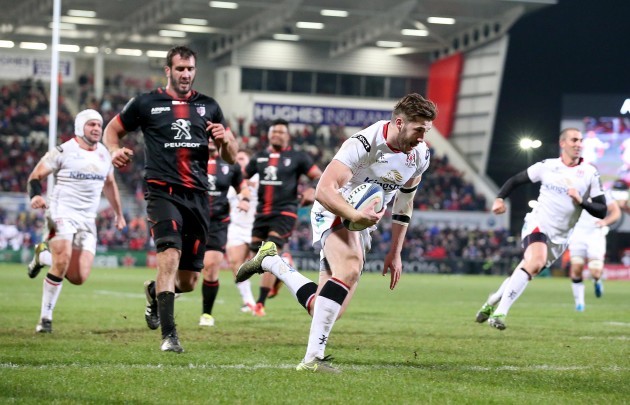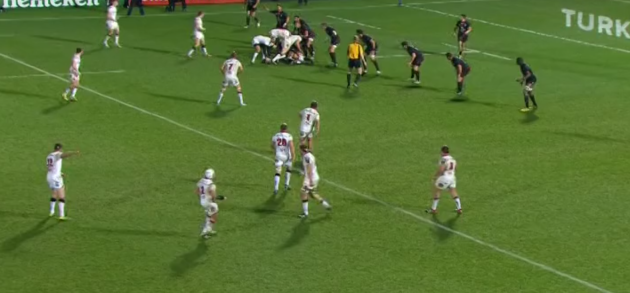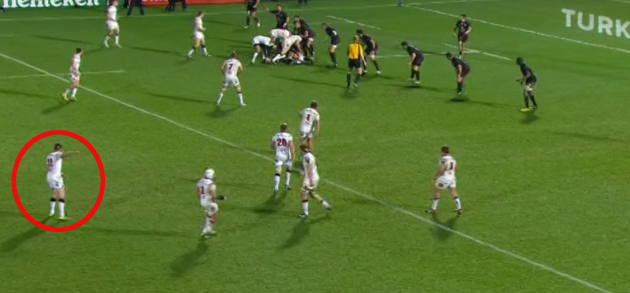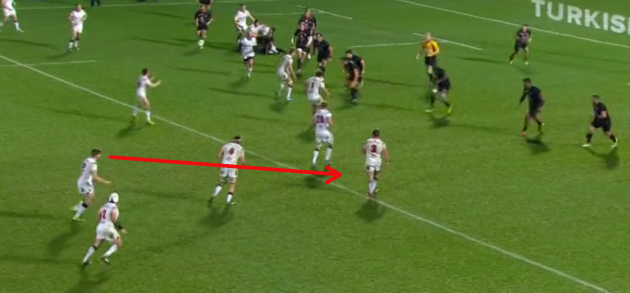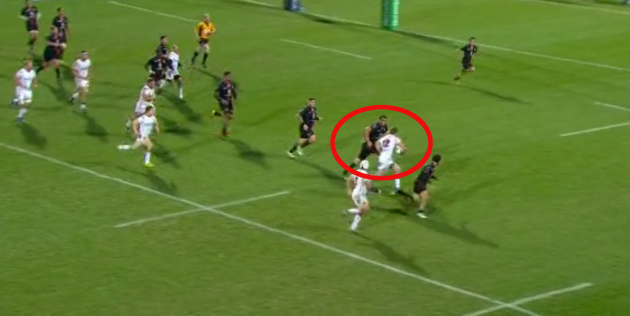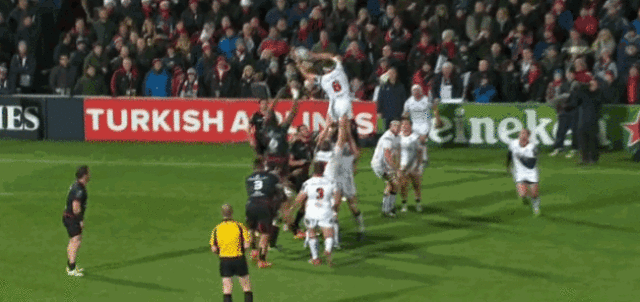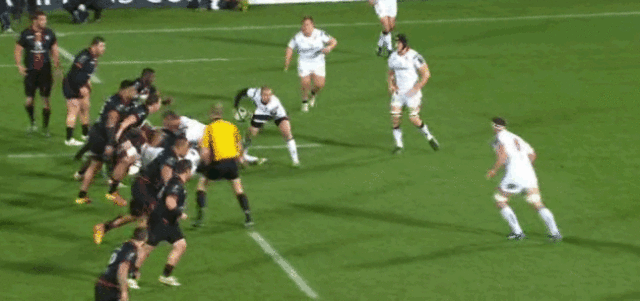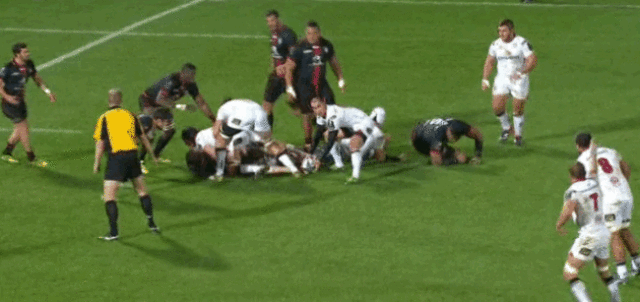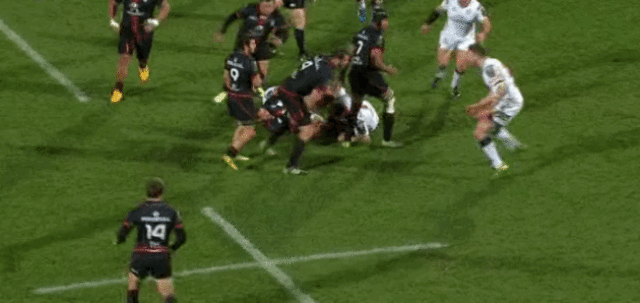THE TEMPTATION IN Ireland is often to be cautious in exposing youngsters to international rugby before they’ve built up considerable experience at provincial level, but Stuart McCloskey is ready for a Test cap.
The Bangor man is in scintillating form for Ulster again this season, showing that his skillset is rapidly improving to match his unique physical attributes.
6′ 3″ tall and weighing in at close to 110kg, McCloskey is of ideal dimensions for Test rugby, but size alone is not enough in the international arena.
The former Bangor Grammar student has the dynamic power, pace and footwork to ensure his bulk can be a true force, while he has made huge strides in his game intelligence and skill level since his senior Ulster debut in February 2014.
McCloskey’s improvement over the last two seasons highlights him as the kind of player who adapts comfortably when asked to shift up a standard of rugby, always an encouraging sign for coaches.
Physically, the fact that he was something of a late bloomer is perhaps in McCloskey’s favour. He came into the senior game prepared to cope with the demands on his body, and the professional conditioning he has received since has only improved matters.
McCloskey’s performance last weekend against Toulouse in the Champions Cup was the latest marker of his growing quality. Ulster travel to Stade Ernest Wallon for the return leg on Sunday, providing the 23-year-old with another chance to grab Joe Schmidt’s attention.
The try McCloskey scored against the French side at Kingspan Stadium was the obvious highlight of his display, although it probably didn’t come as a huge surprise to those who were already well aware of his pace and footwork.
The score did, however, underline McCloskey’s improved intelligence and confidence as he ruthlessly picked out a weakness in the Toulouse defence.
The footwork and burst of acceleration stand out here of course, but our main interest is in McCloskey’s identification of the opportunity. The best backs in the world are constantly scanning and assessing the defence for chances to break and McCloskey does that wonderfully well here.
Even before Ruan Pienaar has initiated the phase by passing from the base of the ruck, McCloskey has already made a decision as to what he’s going to do.
As we see above, McCloskey is actually signalling to where he wants to go as he communicates the opportunity to out-half Paddy Jackson, who was also superb for Ulster.
As the pass heads towards Jackson from Pienaar, McCloskey gets his head up again just to confirm his decision.
What is it that McCloskey has picked out?
One of the reasons for scanning the defence is the hope of spotting ‘fatties’ (front rows and slow-moving locks) in exposed positions near the outside edge of the line.
These players are far more suited to defending close to the ruck, where their relative lack of pace and agility cannot be exploited as easily in a congested area. McCloskey has spotted second row Yoann Meastri (circled in red below) in a wide channel.
Just inside Maestri is Cyril Baille (in yellow), a replacement loosehead prop. As important as both of these men is the presence of Rory Best outside McCloskey, ensuring that Toulouse left wing Arthur Bonneval is going to have to drift off McCloskey and cover the Ulster hooker.
McCloskey has processed all of this and he expects to make the break here, he knows he will. There is no doubt in the Ulster centre’s mind; this is his opportunity to strike.
He does so by briefly and subtly slowing to accept Jackson’s pass, then darting to Maestri’s outside shoulder. Importantly the ball is still in two hands at this stage, so Bonneval is convinced into covering the possible pass from McCloskey to Best.
Only after Bonneval drifts onto Best does McCloskey shift the ball into his right hand, freeing himself for a possible fend on Maestri with his left hand.
McCloskey considers the fend but realises that his second burst of pace has taken him beyond even a despairing dive from Maestri. Scrum-half Sébastién Bezy is the man sweeping across behind the line for Toulouse and McCloskey could probably fend him and score in the right corner or even attempt to run right over the 72kg halfback.
Instead he uses that superb footwork of his after eyeballing the right corner, stepping back inside to allow himself to dot down under the posts.
It’s a remarkable try, but McCloskey understands as well as anyone that these big ‘x-factor’ moments are reduced in importance if he doesn’t back them up with solidity and effectiveness for the remainder of the game.
He is providing that for Ulster regularly, with his more direct ball-carrying from set-piece or slow possession as impressive as you would expect from a man of his physical output.
Clearly he is the type of player who thrives on front-foot possession, but he’s also capable of creating that for his side. The above is a typical example, as Ulster hit him up in midfield from a lineout and McCloskey ekes out additional metres after the initial contact.
He bursts through the tackle of Luke McAlister and Toby Flood, positively crawling forward. He won’t always get away with that exact action on the ground, but the point here is his eagerness to make yardage for his team.
Schmidt’s Ireland have repeatedly used their inside centre, Robbie Henshaw, in this manner from set-piece, although most teams in the world do so. It’s unglamorous at times, but McCloskey appreciates the importance.
He also provides strong offloading possibilities in these situations for any wings who are intelligent and alert enough to trail in his wake. Ruck security is a priority much of the time for Ulster and Ireland, but McCloskey is a potential offloading outlet.
Big centres are rarely known for their strength as distributors, and this is an area where McCloskey has had to perhaps work hard. That said, his underage history in rugby includes time in the halfback positions, so he is far from a blunt battering ram with no skill.
Ulster haven’t been afraid to use his soft handling and good decision making to allow them to play in wide channels and that was highlighted again last weekend.
In the clip above, we see McCloskey used as the hub for a sharp loop play that sees Ulster hugely stress the Toulouse defence by getting into space in the wide channel – the most notable element in their game plan last weekend.
It’s a short catch and return pass from McCloskey but anyone who has played in midfield will understand the difficult of throwing it blind, as the Ulsterman does here. All the little details from McCloskey are positive in this instance.
The 23-year-old keeps his head up at the defence, rather than giving into the temptation to look over his left shoulder for Jackson early. His body is square up the pitch too, meaning that even when Flood reads the play he can’t burst up early enough to intercept the pass.
Outside McCloskey, Luke Marshall – who was absolutely superb in the midfield too – runs an excellent line against the grain to force Toulouse 13 Gaël Fickou to sit down and leave space outside for Jackson to attack.
The pass from McCloskey back to Jackson is ideal – not too hard, at chest height and out in front of the out-half as he looks to begin moving up the pitch again. It’s a simple moment in real time, but one that takes a considerable amount of skill from the Ulster inside centre.
Ulster’s confidence in McCloskey’s growing skills and understanding of the game is obvious in the example below too, as Jackson gets the ball into his 12′s hands nice and early.
The temptation for Jackson here is to run to the line himself, interesting defenders before releasing the ball to McCloskey. However, he understands that Ulster want to play to width and shifts the pill on accurately with a lack of fuss.
McCloskey now has multiple options. Andrew Trimble (red) is trailing inside him for an inside pass, McCloskey can carry himself (blue), and he also has Luke Marshall and Louis Ludik (yellow) providing the possibility of going wide.
McCloskey uses his footwork very well again here, putting himself under pressure by carrying towards the defence before releasing the ball (as he did for the loop play). He straightens back inside as if to use Trimble or carry himself, but then almost instantly cuts back out to pass.
That allows him to pass off his strong inside foot, therefore providing more power in the pass as he goes wide. The shift of footwork has forced Fickou to sit down briefly again, reducing the prospect of an intercept. Ulster are into space on the outside edge.
Even when McCloskey isn’t on the ball, he’s looking to be as effective as possible. Below, we see him getting a blocking action in on McAlister to allow Craig Gilroy to burst through the Toulouse line.
It’s very subtle from McCloskey but he knows exactly what he’s doing as he gets himself to McAlister’s outside shoulder beyond the ball. It’s illegal of course, but McCloskey does it in a manner that doesn’t attract too much attention in his direction.
The likes of Ulster attack coach Neil Doak and Schmidt are huge on players ‘staying big’ after they pass or when they’re beyond the ball, and McCloskey does so here.
Defensively, McCloskey is showing good habits too as his awareness and communication grow. There are certainly strides of improvement to be made in this department and it’s generally the area where young midfielders struggle most when introduced to Test rugby.
McCloskey’s agility and acceleration mean he doesn’t suffer as badly as other tall centres do when confronted with footwork or intricate movement by the opposition attack, though that will move to another level if Ireland call on him.
Little habits like the slapping down of an attempted fend by Maestri in the example above are encouraging. McCloskey’s temptation might often be to hammer himself into a hit, but this diffusion of the fend allows him to tackle with more certainty.
That said, there’s a time and place for unleashing and McCloskey has shown an ability to do so in the tackle in recent seasons. His composure and accuracy in the choke tackle has also been very impressive, as he uses his height and strength to hold isolated ball carriers off the deck and force turnovers.
All of those qualities will have been noted by Schmidt and though Ireland have other centres ahead of McCloskey in the ‘pecking order,’ his form continues to suggest that the sooner he is capped and given international experience, the better.
Backing up his latest strong performance in Toulouse will be important, but McCloskey is already showing that he has unique tools and is willing to work hard at improving all the other important ones.
